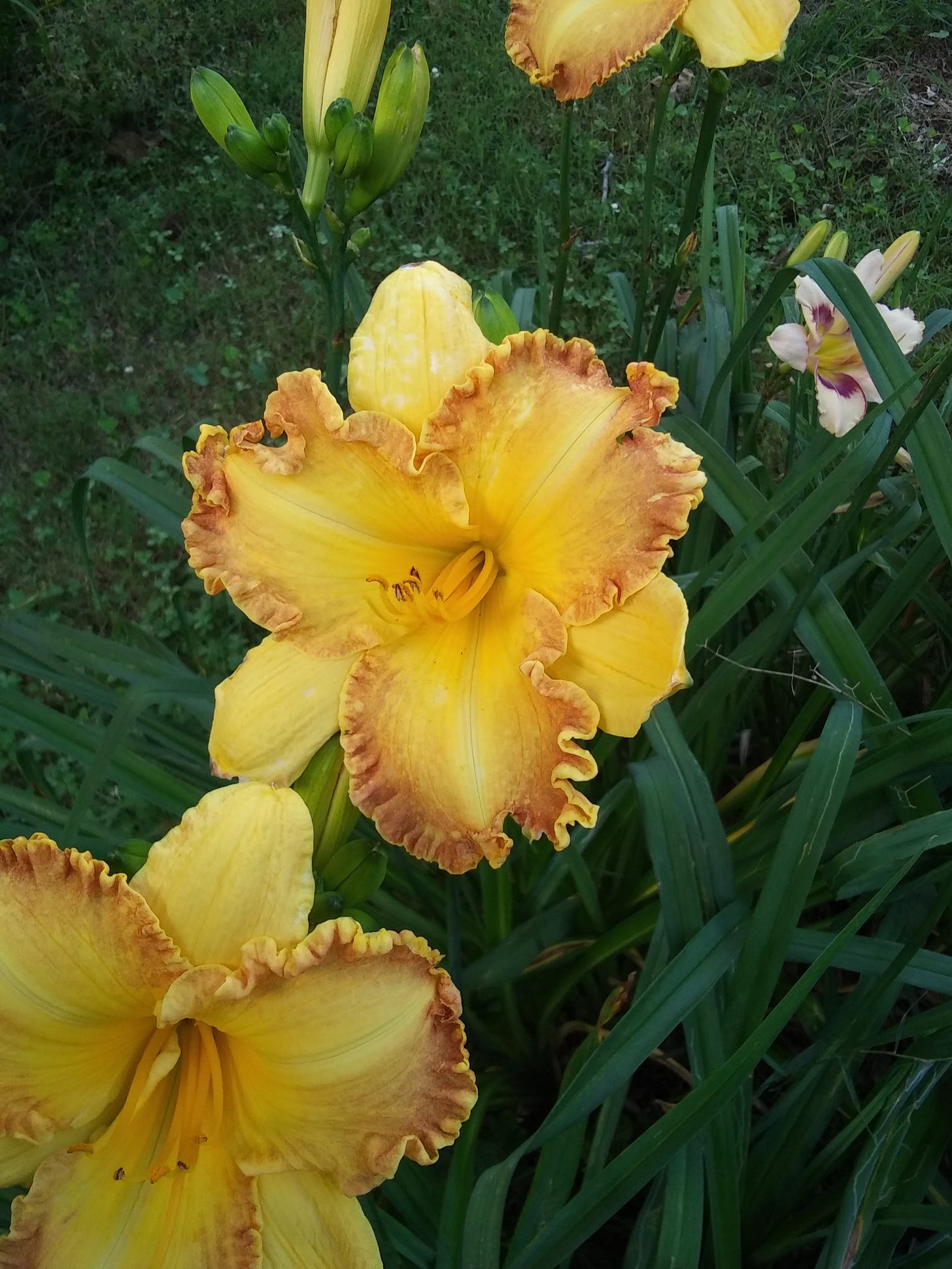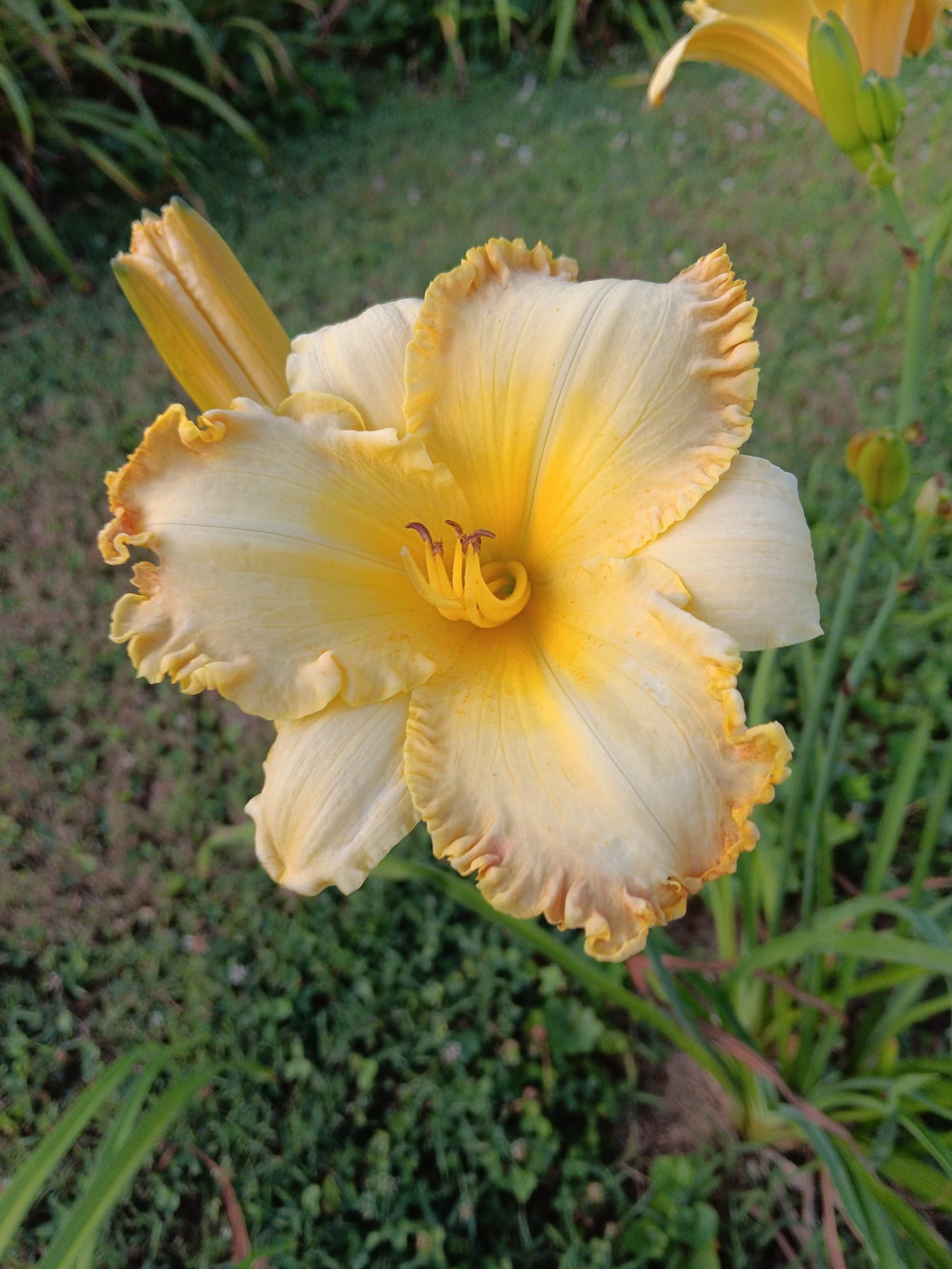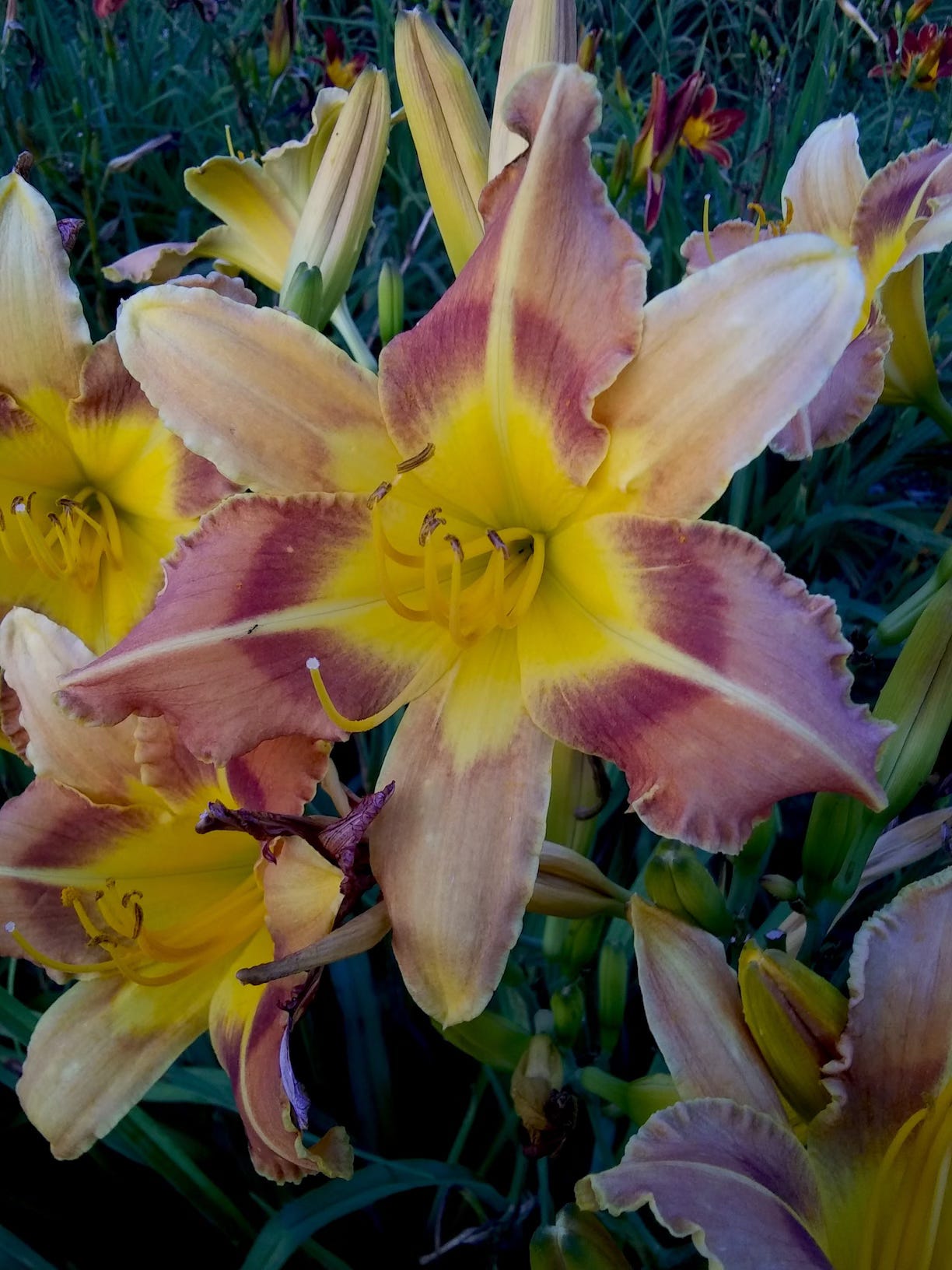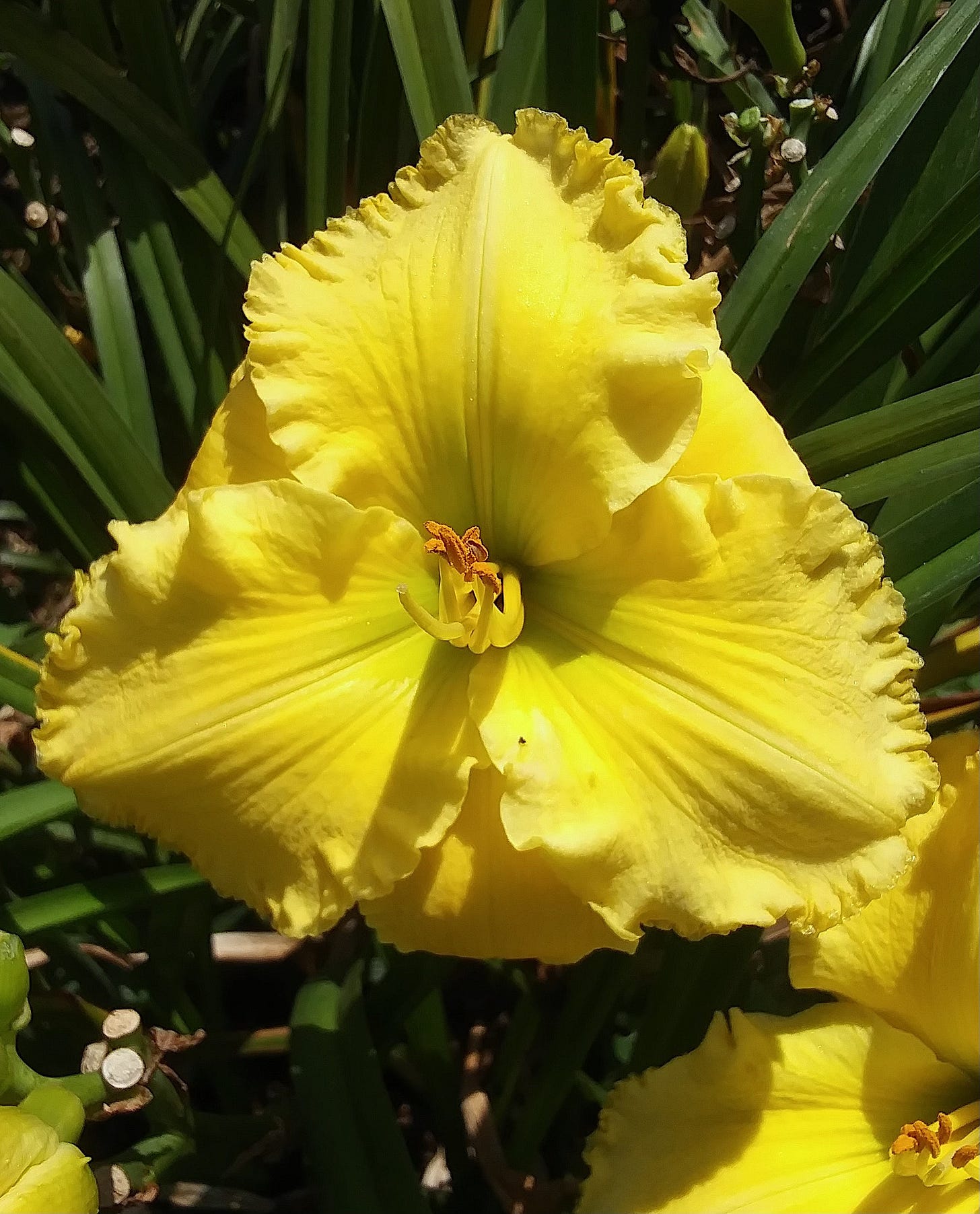Monday, July 21, 2025
Announcing 2025 Summer/Fall Sale at Sun Dragon Daylilies
Thursday, January 30, 2025
A Note About Recessive Genes
This post is a little lesson in the power of ancestry and recessive genes. Never underestimate the power of recessive genes, carried at the heterozygous level, to reappear and create considerable advancements in phenotype that might be mistaken for a "mutation" or major "leaps" in your program. When you don't see a trait in the seedlings of a cross, that doesn't mean you "lost the trait (gene)". It almost always means that the trait is recessive and is now heterozygous and not seen in the seedlings, thus not "lost". We far too often only think about what we see, but if you know what a given plant or animal in your program carries, then you can utilize it to full advantage.
In this example, in the images below, we see two of my introductions 'Sun Dragon' and 'Substance Upon Substance', and three seedlings from the cross of these two cultivars. You can see a considerable increase in ruffling, as well as the reemergence of the melon mutation in one example, carried recessively by both parents, and dilution factors creating lighter colored flowers than either parents, also carried from ancestors such as Solaris Symmetry (pod parent of Sun Dragon).



We also see a tendency toward edge-no-eye coloring in all three seedlings (deriving from SUS, who shows a hint of that as the color changes through the day) and the final seedling shows some pink splashes of broken patterning, another trait that SUS occasionally shows. Pink is possible out of an "orange" and a "yellow" because Sun Dragon has a lavender parent, multiple pink ancestors (Janice Brown, Mystical Rainbow), and expresses a layer of lavender anthocyanin over a golden carotenoid base which results in our eyes perceiving it as "orange".
Sun Dragon, often perceived as "just an orange", actually produces many lavender and pink seedlings. Substance Upon Substance also carries pink, which expresses as a rose overlay that gradually fades away during the day, first revealing the yellow under color, before the flower fades on to a cream/beige by late evening.
Never underestimate those hidden, heterozygous recessives!
_______________________________________________________________
Check out my new Substack where I am posting my older poultry and daylily articles and will be writing about genetics and breeding in the future - The Art Of Breeding with Brian Reeder
For those interested in my daylilies, you can read about my program at my website Sun Dragon Daylilies. You can find the complete list of my daylily cultivar introductions at the website, as well as a section of categories that my introductions fall into, which makes finding the specific things you are interested in much easier. You can also find a page covering the introductions from my program that have high permacultural applications. Finally, to read all the fine details of my program, see my blog, Daylily BReeder, and specifically the Main Page detailing my breeding program.
My poultry books, An Introduction to Color Forms of the Domestic Fowl and An Introduction to Form and Feathering of the Domestic Fowl are available through Amazon.
I offer one-on-one consultation for those who have specific questions or issues in their own breeding programs, and I offer mentoring for those who wish to take their program to the next level.
Sunday, December 22, 2024
New 2025 Introductions
LAVENDER BLUE ROYALTY
Cultivar Name: Lavender Blue Royalty
Seedling Number: PHLF6
Bloom Diameter: 5”
Scape Height: 28”
Branches: 3
Bud Count: 15
Bloom Season: Mid-Late
Rebloom: Yes
Color/Description: Amethyst purple with darker purple band and double edge, one faint edge same as band and the outer edge light bluish-white, above green to chartreuse throat.
Ploidy: Dip
Bloom Habit: Diurnal
Foliage: Dormant
Pod Parent: Phoenician Royalty
Pollen Parent: Lavender Feathers
Year Bred: 2012
Rust Resistance: A+/5 year
Fertile: Both ways
For a complete list of my available daylilies and pricing, click here.
Comments: Lavender Blue Royalty is a seedling from the early days of my breeding program that went through all five years of my rust resistance testing program with an A+ resistance rating all five years. It has been a very interesting flower. When it was growing in the hybridizing garden, which has afternoon shade and low 5.6 - 6.0 pH levels, the flowers were intensely purple with very strong blue tints. The blue was so strong in that garden that it was shocking to me. As you can see in the first two pictures below, it was intensely, deeply pigmented with a strong double edge, the inner one dark purple like the band and the outer one a bright sky blue, with the blue being even stronger to the naked eye than it came out in pictures. Once I moved the plant to the line out garden though, where there is full sun all day and the soil is a neutral 7.0 pH, the flower has rarely shown such depth of coloring. In the line out garden it tends to be a very bluish lavender with a pale whitish/blue outer edge and a darker lavender inner edge that is matched to the band. The last four images below show Lavender Blue Royalty during different times in the afternoon in the line out garden. The next to the last image below was included both to show you the plant and because a flower of Substantial Rosebud is in the background of the image to contrast its strong rose-pink coloring with the strongly blue-lavender coloring of Lavender Blue Royalty in the full sun in the line out garden.
Regardless of the particular color saturation phase, Lavender Blue Royalty shows a lot of blue pigment, combined with strong rust resistance, and that is why I have kept it so long and introduced it this year. It is fertile both ways and I think it can be a very useful breeder for both rust resistance and intensely purple coloring in the blue-toned direction. The thrips resistance is only average, which is typical for most daylilies, and it is better than many purples, of which many are below average. Many of the seedlings I have seen from it also show the intensely bluish lavender to purple coloring and many also showed high rust resistance. The foliage is dormant and looks nice. The branching is average as is bud counts. The reason I am introducing it is the exceptional rust resistance and the exceptional pigmentation. As with many of my introductions, I suspect the branching and bud count will increase in gardens where inputs such as water and fertilizer are used.
KOREAN DRAGON KING
Cultivar Name: Korean Dragon King
Seedling Number: HFKWSM22
Bloom Diameter: 6”
Scape Height: 52”
Branches: 5
Bud Count: 23
Bloom Season: MID-LATE
Color/Description: Medium orange with darker red-orange band above chartreuse throat with wide, antler-like branching.
Ploidy: Tet
Bloom Habit: Diurnal
Foliage: Dormant
Pod Parent: H. fulva 'Korean' clone
Pollen Parent: Women Seeking Men
Year Bred: 2018
Rust Resistance: unknown, bred after my screening program ended. Pod parent is A+/5 year and pollen parent is 3 year/B.
Fertile: Both ways
For a complete list of my available daylilies and pricing, click here.
Comments: Korean Dragon King is really something special. A first generation seedling from H. fulva 'Korean' (Apps accession) crossed to Women Seeking Men, it is a magnificent combination of the two parents. It shows the tallest scapes I have gotten from the many crosses I have made using this species clone pod parent. It also has the most elaborate and impressive branching of any of the seedlings I have produced from fulva 'Korean' (and I have many), showing the power of Curt Hanson's selection for incredible antler-like branching, and especially the high breeding value of his cultivar 'Women Seeking Men'. Of Curt's program, which I have worked with a great deal, Notify Ground Crew and Women Seeking Men have been the two most important of his introductions in my own work.
Korean Dragon King shows great traits from both parents, with extreme vigor and robustness coming from the fulva 'Korean' pod parent. While the flower is the classic orange of the pod parent, it has a flush of pink which becomes more obvious in the evening (second picture below) when the intensity of the orange coloring lightens letting the pink pigment express in a visibly peach tone. The flower also shows petal broadening and flatter form than the species clone pod parent, which came from the pollen parent.
The plant is fertile both ways, and as you can see in the last picture below, it sets pods well, meaning it has a great future for breeding, allowing for creating tall, robust scapes with amazing branching while bringing in the species genetics of the pod parent to open up bottlenecked hybrid tetraploid lineages. In addition to its high breeding potential, it is also a lovely garden display (third image below) making a nice clump that does not spread by runners. The flowers, wider and flatter than the fulva clones, also represents an improved fulva look, allowing it to present with a species-like look, but with larger flowers, having more substance and impact in the garden. Korean Dragon King is also very useful for permacultural uses, both for its own traits, and for breeding new and improved permacultural daylily specimens. While most of my introductions for 2025 show more advanced flowers, I think that Korean Dragon King may be the most important introduction from my program for the 2025 season.

















%20X%20(TFF%20X%20-)%20A%203.jpg)
%20X%20(TFF%20X%20-)%20A%2033.jpg)








